ACES
Context
Problem: The rise of disinformation in online spaces across the world, from organized misinformation attacks, to the prevalence and rise of anti-information groups like anti-vaxxers.
Goal: Design and explore the feasibility of an Accountability & Content Evaluation System (ACES) with incentives for users to engage in community-based content moderation.
- Role: User Researcher
- Team Size: 4
- Duration: 4 weeks
- Tools: Figma, Usability Tests
Process Overview
jump to section Literary Research:
My team and I reviewed several HCI papers on social media moderation and conducted competitive analysis to see what the current methods for moderation are, as well as their strengths and weaknesses. We also scoped down our design to move away from a fact checking framework, and instead, designed it to act as a basis for establishing epistemological media literacy, or in other words, provide context instead of flag posts as false.
jump to section Design:
To address the points we found in our research we split our design space into two different systems: Post Evaluation, and Gamification. In post evaluation we came up with a 4 tiered system, with each tier slowly building upon the previous stage so as to not give any one user too much power or work. However having a potential moderator only able to do 1/4 the work of moderating a post steeply increases the amount of community moderators needed. So we designed a currency that could be exchanged for ad removal, post visibility, or gifts. We also designed badges, achievements and stats summaries that could be shown off on the user's profile for further incentivization.
jump to section Evaluation:
After coming up with final designs of each section of the system, we made low fidelity prototypes that were scripted together to be clicked through and ran usability tests to evaluate them. The main takeaway of this testing led us to shift our design by having the warning banner for contentious posts appear half way into the video, in theory, after the viewer gets invested but before they make up their mind.
jump to section Conclusion:
As social media companies grow, so do the unique nuances in their diaspora of internet cultures. This makes traditional moderation harder and harder as it must adapt to the specific subgroup it is moderating. Incentivising a community to perform its own moderation with tools that provide them the ability to foster perspective answers this concern.
Literary Research
My first step was to help inform the team via a competitive analysis, as other members looked up, current moderation standards, and current best practices in literary discourse.
I found that there were three primary methods of moderation, algorithmic, professional, and community. Algorithmic moderation is a good preliminary step for sifting through the worst content offenders and has the most throughput, it also has the highest ratio of edge cases, and misclassifications. So most platforms use 3rd party professional moderators to sort through the edge cases however these two moderation techniques leave two problems. The first is “coded” language: where a clique of the internet establishes their own meanings for phrases allowing them to pass off hate speech as seemingly innocuous language which professional and algorithmic moderators have hard time detecting. And secondly misinformation, which oftentimes falls within platform code of conduct and isn't moderated at all. Both of these issues can be addressed by the third type of moderation community moderation. But poorly implemented community moderation like in Reddit's case can lead to severe echo chambers and even to condoning posts against the platform's code of conduct. However change this behavior can be as simple as Twitter's implementation where they randomly choose tweets for its community moderators to look at. (More information about these moderation techniques can be found in the full report at the top of the page.)
My research led me to suggest to my team that we change scope down our design to move away from a fact checking framework, and instead design ACES to act as a base for epistemological media literacy. Or in other words move from trying to strictly moderate posts via community moderation and instead do" soft moderation" (using informational summaries and warnings) and design the system in such a way as to be able to pass important information to the platform hosting the content.
After summarizing the rest of the teams research findings and we came up with the following research takeaways:
- Design Constraint: Literature has shown that community
moderators are seldom as accurate as professional moderators.
Solution: Design our implementation to focus on binary metrics and a focus on increasing perspective rather than trying to give posts a quantitative trustworthiness score. - Design Constraint: Each social media platform has unique
interactions methods making a one-size fits all solution infeasible.
Solution: Reduce solution space to only TikTok as they have a strong reliance on their algorithm which historically leads to echo chambers, and they have some of the weakest content moderation. - Design Constraint: Currently, the majority of social media
platforms rely on user's altruistic tendencies to participate in content
moderation.
Solution: Derive incentives to gamify the peer review process.

Design
Our ACES system was divided into two design spaces, 'Post Evaluation' where the trustworthiness of a post is evaluated, and 'Incentives' where we designed active and passive benefits to encourage users to volunteer for the system.
In post evaluation we came up with a 4 tiered system. We tried to design these stages to be completed quickly as so not to interrupt the users scrolling through TikTok.
- Stage 1 is to “verify targeted posts” where a mix of the native audience of the post, and non-native audience from ACES volunteers would be asked if they trust the information presented in the TikTok.
- Stage 2 is to “identify fault” where an even broader audience would be asked first to complete stage 1, then to select from a predefined list of reasons as to why they trust or distrust the post.
- Stage 3 called “summary declaration” asks a few volunteers to write a declaration to help inform other viewers of the post, using the information collected in stage 2.
- Stage 4 would be “verify declaration” where another large group would be asked to pick the most informative summary out of several options.
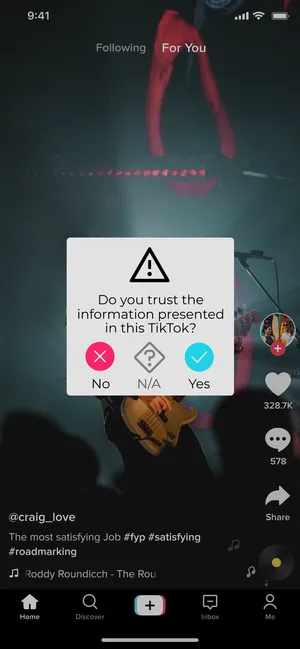
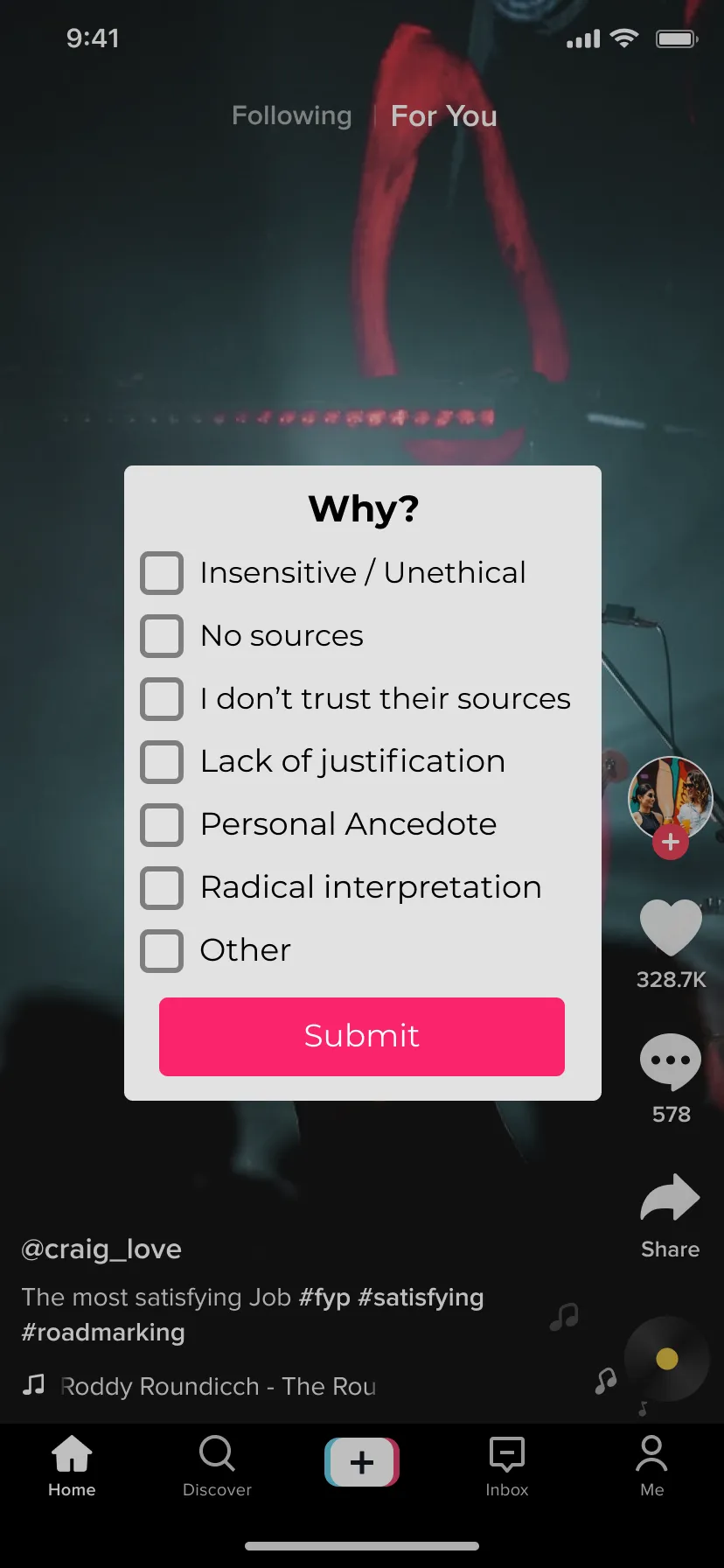
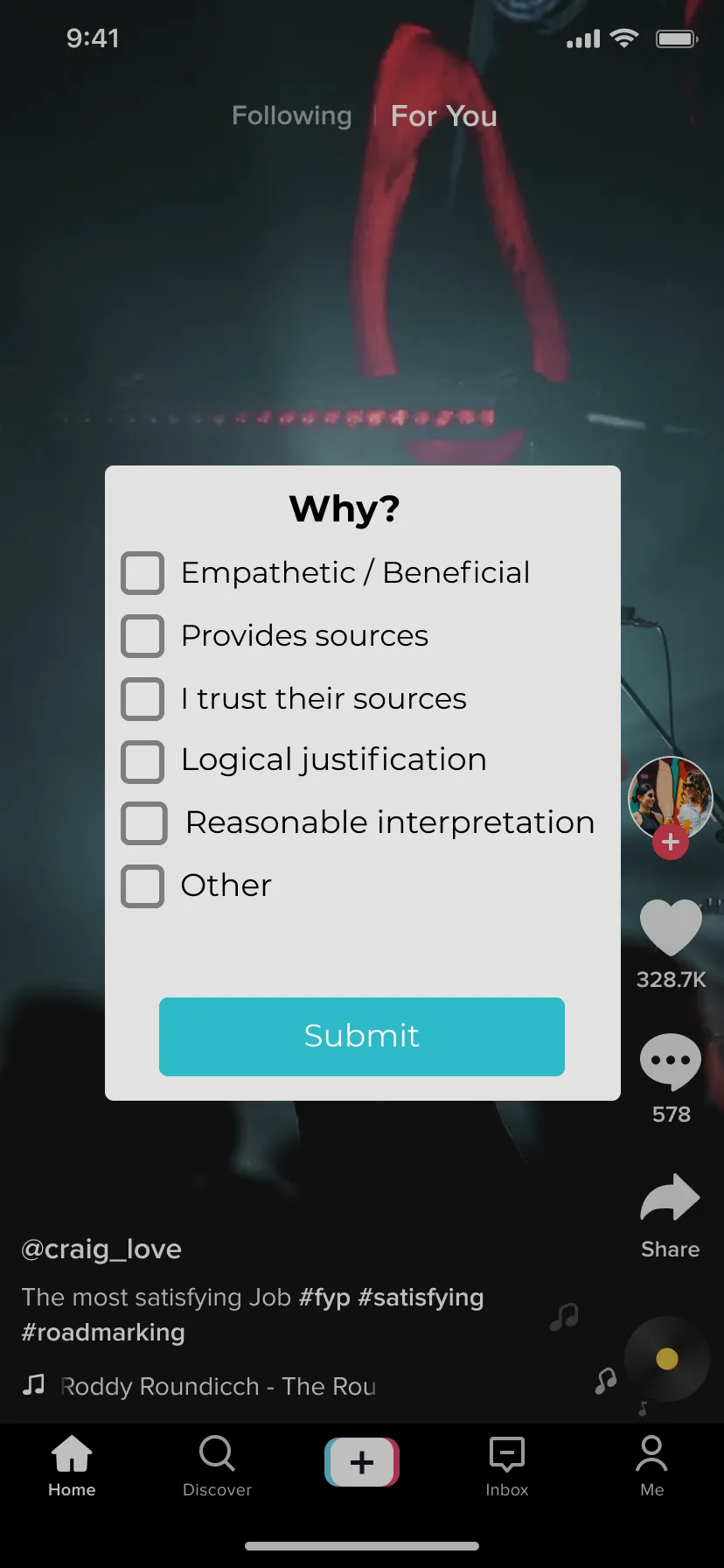
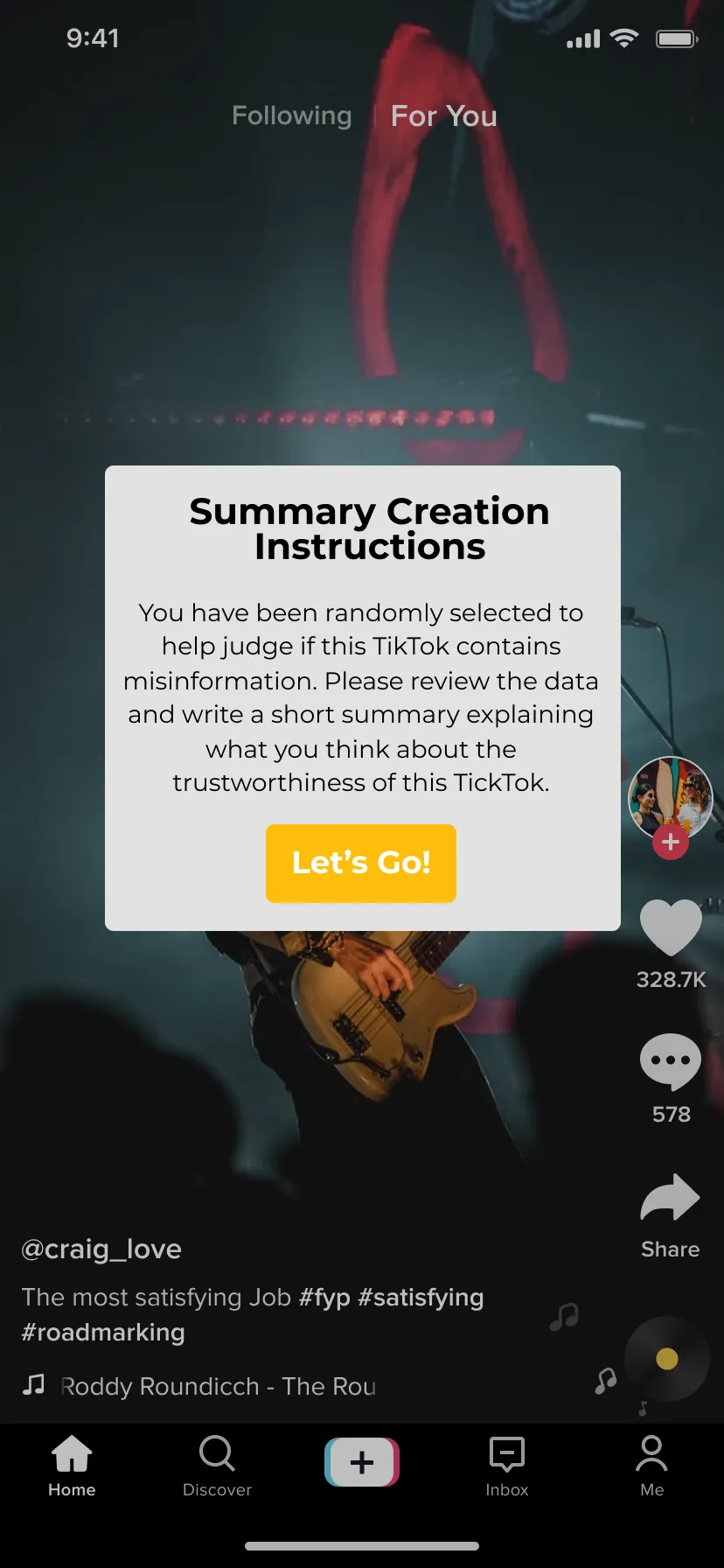
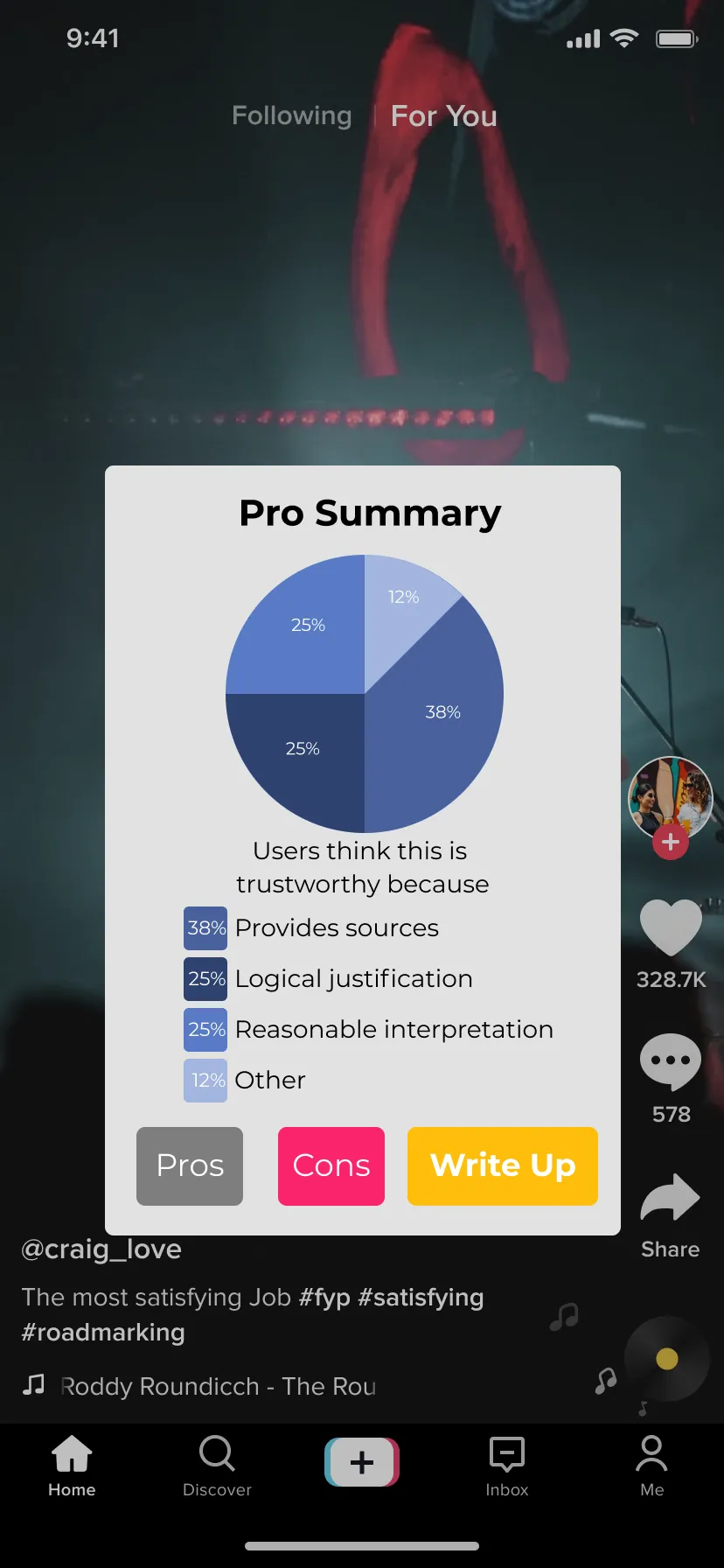
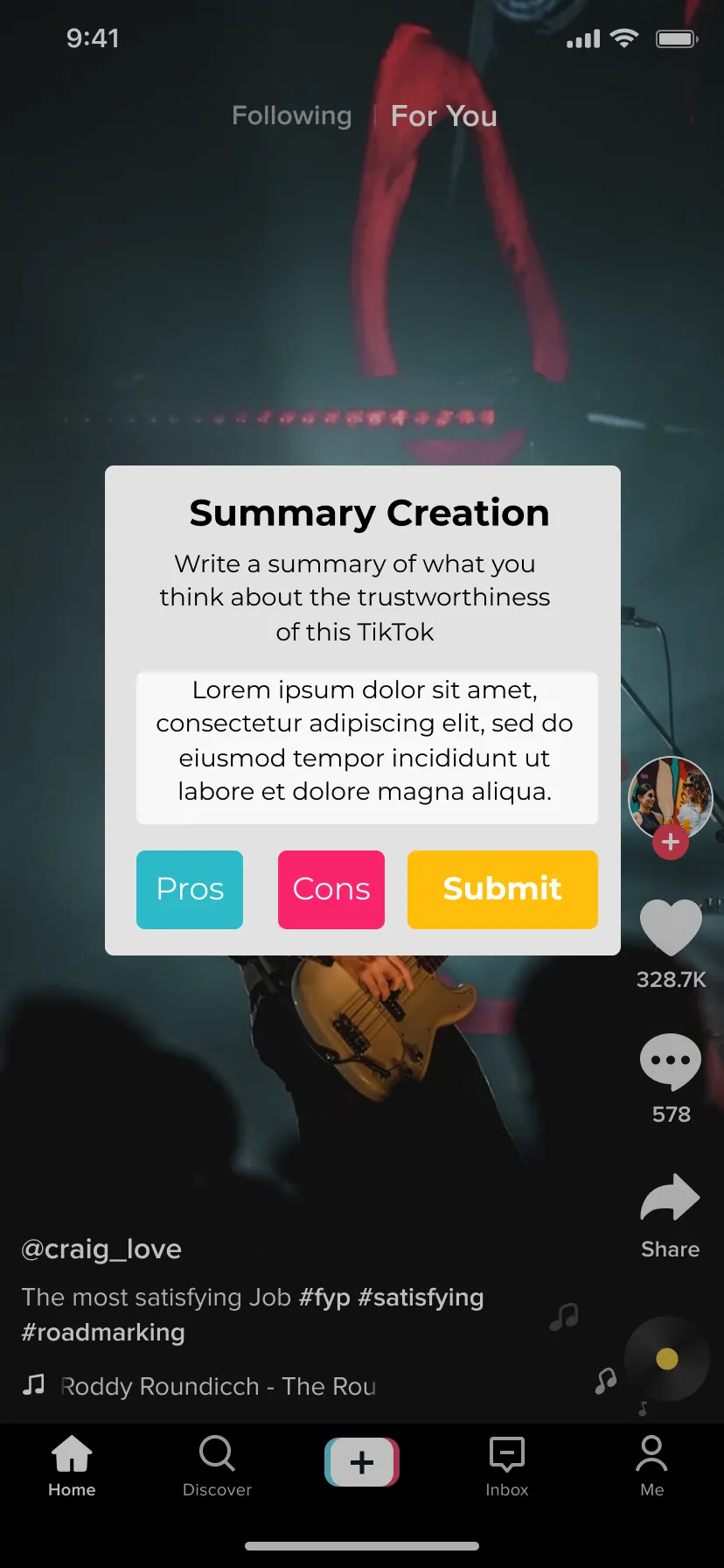
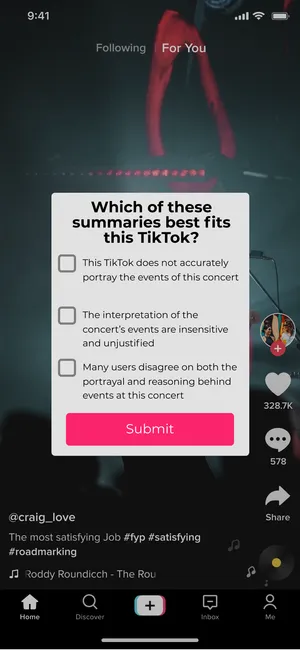
With our system divided into four sections and any one volunteer not being able to participate in more than one section per post ACES would need a large volunteer group to be productive. To address this concern we suggest gamifying the moderation process to allow volunteers to passively quantify their altruism, earn benefits in the app, and show off to friends.
TikTok coins would be the main driver for increased volunteering. Users would be able to exchange coins they get through moderation for supporting influencers, ad removal, or post visibility.
Next would be the passive systems, each designed to encourage different types of users to volunteer. For social-users we suggest being able to view details about their moderation style, including how often they matched the eventual moderation consensus of a post. Or how often a post they helped moderate got removed, to increase the feeling of altruism.

For more progress oriented users ACES would have sets of moderation tasks to receive bonus TikCoin, badges. For instance a “quest” could pop up on the user's profile page and ask if they would like to begin the quest to complete a certain number of moderation tasks, in order to receive a bonus. Once acquired these badges could be selected to be displayed on their profile page.
Evaluation
After coming up with final designs of each section of the system, we made a low fidelity prototype that was scripted together to be clicked through and ran usability tests to evaluate them. The test included a short survey at the end to help assess the incentivization of our gamified designs. However such feedback and our takeaways were limited due to not having enough time to prototype out the gamification features or run the usability test with a large number of volunteers. Nevertheless our testers revealed the following information:
- Just the presence of a moderation task alters the moderator's opinion of the post.
- Most testers spent a long time writing declarations, however, a minority of testers enjoyed stage 3 the most.
- Around half of the testers mentioned they would just click through a warning banner if it appeared before or after a post.
- For the gamification aspect one user noted that implementing the ability to send gift currency was also a point of contention for an app that children used.
These takeaways led us to shift our design by having the warning banner for contentious posts appear half way into the video, in theory, after the viewer gets invested but before they make up their mind. And while not specifically designed, we suggested an algorithm that could be made to pair ACES community moderators with their favorite tasks. Finally we removed the gift ideas, as not only did it spark contention in one of our testers, it was also the lowest motivating ranked overall.
Conclusion
Moderation solutions for social media need to adapt to the changing attacks on our information spaces. As social media companies grow, so do the unique nuances in their diaspora of internet cultures. This makes traditional moderation harder and harder as it must adapt to the specific subgroup it is moderating. Incentivising a community to perform its own moderation with tools that provide them the ability to foster perspective answers this concern. This draws in the second key design space of ACES, incentivization. While the gamification, and the incentives listed in our design are not new our literature review showed very little integration of these systems into moderation. Our contribution to this space is envisioning how these systems can be used to foster a grass roots moderation for posts regardless of post status. We see this as an improvement on Twitter's Birdwatch system whose hands off approach limits their volunteers reach to popular posts disproportionately and almost never extends to fringe communities.